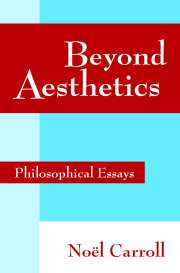Book contents
- Frontmatter
- Contents
- Foreword by Peter Kivy
- Introduction
- PART I BEYOND AESTHETICS
- PART II ART, HISTORY, AND NARRATIVE
- PART III INTERPRETATION AND INTENTION
- Art, Intention, and Conversation
- Anglo-American Aesthetics and Contemporary Criticism: Intention and the Hermeneutics of Suspicion
- The Intentional Fallacy: Defending Myself
- Interpretation and Intention: The Debate between Hypothetical and Actual Intentionalism
- PART IV ART, EMOTION, AND MORTALITY
- PART V ALTERNATIVE TOPICS
- Notes
- Index
Art, Intention, and Conversation
Published online by Cambridge University Press: 19 January 2010
- Frontmatter
- Contents
- Foreword by Peter Kivy
- Introduction
- PART I BEYOND AESTHETICS
- PART II ART, HISTORY, AND NARRATIVE
- PART III INTERPRETATION AND INTENTION
- Art, Intention, and Conversation
- Anglo-American Aesthetics and Contemporary Criticism: Intention and the Hermeneutics of Suspicion
- The Intentional Fallacy: Defending Myself
- Interpretation and Intention: The Debate between Hypothetical and Actual Intentionalism
- PART IV ART, EMOTION, AND MORTALITY
- PART V ALTERNATIVE TOPICS
- Notes
- Index
Summary
In the normal course of affairs, when confronted with an utterance, our standard cognitive goal is to figure out what the speaker intends to say. And, on one very plausible theory of language, the meaning of an utterance is explicated in terms of the speaker's intention to reveal to an auditor that the speaker intends the auditor to respond in a certain way. That is, the meaning of a particular language token is explained by means of certain of a speaker's intentions.
Likewise, in interpreting or explaining nonverbal behavior, we typically advert to the agent's intentions. This is not to say that we may not be concerned with the unintended consequences of an action; but even in order to explain unintended consequences, one will need a conception of the agent's intentions. Nor is this reliance on intention something that is relevant only to living people; historians spend a great deal of their professional activity attempting to establish what historical agents intended by their words and their deeds, with the aim of rendering the past intelligible. Furthermore, we generally presume that they can succeed in their attempts even with respect to authors and agents who lived long ago and about whom the documentary record is scant.
Nevertheless, though it seems natural to interpret words and actions in terms of authorial intention, arguments of many sorts have been advanced for nearly fifty years to deny the relevance of authorial intention to the interpretation of works of art in general and to works of literature in particular. Call this anti-intentionalism.
- Type
- Chapter
- Information
- Beyond AestheticsPhilosophical Essays, pp. 157 - 180Publisher: Cambridge University PressPrint publication year: 2001
- 10
- Cited by



